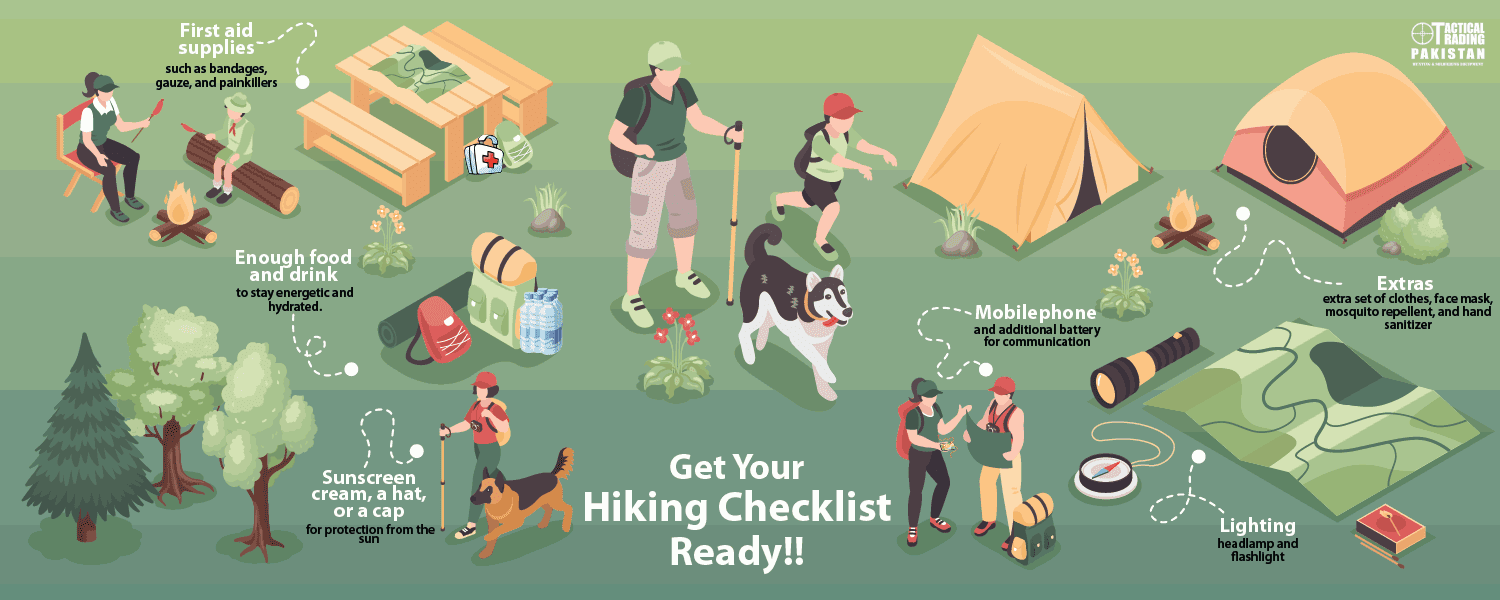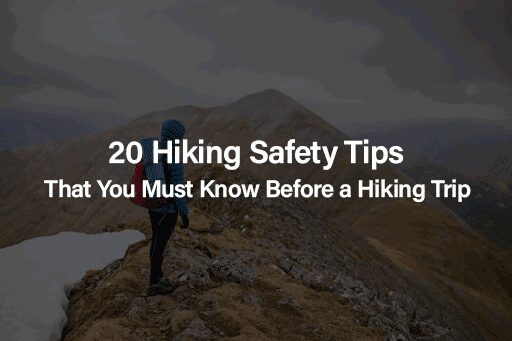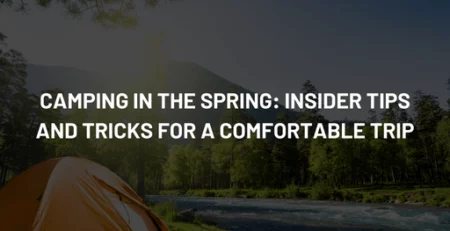20 Hiking Safety Tips That You Must Know Before a Hiking Trip
Whether you’re getting out of shape at the office or trying to enjoy the outdoors with your friends, hiking is a healthy and great way to spend time. Hiking is a great way to get outdoors and enjoy the beauty of nature. However, it is important to be aware of the potential dangers involved in any hike. We have curated a list of top hiking safety tips to help you have a safe and enjoyable hike
The weather is a major concern when it comes to outdoor activities like hiking. Extreme temperatures, lightning, and heavy rain can incapacitate you before you start your trip. As a result, it’s critical to plan ahead and prepare for these various situations so that no matter what happens, you’re covered.
List of Top 20 Hiking Safety Tips
- Know exactly where you are going
- Pack appropriately and dress accordingly
- Go for a small trial hike before taking on a major one
- Bring a first-aid kit along
- Buy proper hiking boots and socks
- Bring extra water or a purification system
- Bring at least one friend
- Create an itinerary and share it with someone outside of the group
- Play it smart and know your limits
- Stay in sight of your hiking companions
- Stay on the trail
- Don’t overexert yourself
- Do not ruin natural beauty or disturb local animals.
- Respect private property
- Learn to start a fire
- Protect yourself from the sun
- Hike only when the weather is favorable
- Be extra careful on the second half of the hike
- Don’t Wear Headphones While Hiking
- Be ready to turn back

Hiking Safety Tips While Planning the Trip
Safety is not just needed during the trip but it’s important to consider safety while you’re planning the trip as well.
Know Exactly Where You are Going
While it’s perfectly fine to go off the beaten path while hiking, make sure you always have a map or guidebook on hand. Also, take note of any natural landmarks you come across; if you ever need directions, they may come in handy.
Pack Appropriately and Dress Accordingly
What you bring on your hike depends largely on the location and length of the hike. However, there are some essential items you should always remember to pack:
- A first-aid kit
- A flashlight or headlamp
- Sunscreen and insect repellent
- A whistle
- Plenty of water and snacks
You must also pack appropriate clothing and hiking gear. Again, the specifics depend on where you’re hiking and the weather conditions. However, in general, you should dress in layers so that you can easily adjust to changing temperatures. Make sure your shoes are comfortable and provide good support; broken-in shoes will help prevent blisters.
Go for a Small Trial Hike Before Taking on a Major One
This is one of the most important hiking safety tips. If you’re planning a long or difficult hike, it’s always best to do a shorter, easier hike first to make sure you’re physically and mentally prepared for the trip. This will also give you a chance to test out your gear to see if everything works as it should.
Some things are difficult to figure out until you’re actually out there— for example, while hiking, you may suddenly realize that the day is getting cloudy and you need to think about what you are going to do with your pack.
That’s why we recommend a short or medium hike before you start on your full-length hiking adventure. The transition of going from newbies to pros can be tough, so it’s best to do it gradually and start to become familiar with the trails you choose.
Bring a First-Aid Kit Along
When you go on any outdoor adventure, make sure that you have a first-aid kit in your hiking backpack. It is important to have one with you to keep emergency situations under control. You should also learn about how heatstroke and even hypothermia or dehydration happen so that you can prevent any accidents.
Buy Proper Hiking Boots and Socks
Properly fitting footwear makes a big difference when it comes to avoiding injuries like rolling an ankle, as well as blisters. They will also prevent you from experiencing the most painful climbing hindrance: the blisters that come from your sensitive soles. In addition, if you use the right hiking shoes, your feet will be protected from blisters and injuries. Wearing low-cut shoes can lead to a twisted ankle or lower leg injury.
Cotton has a natural tendency to stay moist and can make it harder for feet to breathe. That’s why we recommend choosing a different material that won’t cause this problem.
Have a look at HiTec Skamania WP Hiking Boot which can be your ultimate companion for hiking and trekking.
Bring Extra Water or a Purification System
hikers often overlook the importance of staying hydrated, but it is crucial to drink fluids throughout your hike to maintain your health and energy levels. If you’re going on a long hike, in general, it’s recommended to drink about 1/2 liter per hour of water. It’s also important to ensure that you are drinking this amount at all times regardless of other factors involved.
If there are natural sources of water, don’t forget to bring a way to purify and disinfect it. Boil water in a safe container and carry a lightweight heat source to keep your backpack light.
Bring At least one Friend
Make sure you don’t go on a hike on your own because you could get seriously injured. Invite a friend or two with you so they can help watch out for each other and keep the conversation going to stay calm. This way, if something goes wrong, all three of you will know how to handle the situation!
Create an Itinerary and Share it with Someone Outside of the Group
Having a plan makes for an easier hike. Do this before you start at the trailhead by including your starting point, destination, route, estimated finish time, and how many people are in your group. Then share it with someone not hiking with you. That way, they can track your whereabouts and make sure you’re safe.
Play it Smart and Know Your Limits
It’s always better to be safe than sorry. If you’re feeling tired, take a break. Don’t push yourself harder than you can handle just to try and keep up with the group. Also, be mindful of your surroundings at all times and don’t take any unnecessary risks. If something doesn’t feel right, trust your gut and go back the way you came.

Hiking Safety Tips During Hiking
Stay in Sight of Your Hiking Companions
Never hike alone, even if you are familiar with a trail and believe you could complete it comfortably. Do not wander farther than a few steps from your party’s line of sight
while on the trail. The individuals in your group will serve as your first responders if anything were to happen to you.
Don’t Overexert Yourself
It is important to understand when to take a break and when you should stop. Experts say that if you feel too tired or have difficulty handling the hike after climbing high, it is important to take some rest and communicate your concerns with your group.
Do not Ruin Natural Beauty or Disturb Local Animals
While you’re out enjoying nature, take care not to damage it. Stick to established trails and don’t pick flowers or disturb any wildlife you encounter. Be sure to pack out all your trash so that other hikers can enjoy the same experience you did.
Respect Private Property
If you see a “No Trespassing” sign, it’s best to just find another trail. Hiking on private property without the owner’s permission is not only rude, but it could also get you into legal trouble.
Know How to Start a Fire
Whether you’re just overnighting during your hiking trip with friends or if something unexpected happens and you’re stuck outdoors all night, a fire can be a lifesaver. It will keep away animals, act as a marker for other people to find you, and even provide warmth. Simple equipment like waterproof matches should be enough to get a fire started.
Hike Only When the Weather is Favourable
Pay attention to the weather as well. If there’s a chance of bad weather conditions like severe rain, it might be best to reschedule your trip altogether. Weather forecasts are critical to prevent stormy situations in the face of natural hazards or inclement weather, so hikers should not plan their hikes during the day when weather conditions might not be favorable.
Protect Yourself from the Sun
The high temperatures during the summertime can be brutal, but you don’t have to suffer; there are ways to beat the heat. If you’re an experienced hiker, start your hike at first light or after sunset when the temperature has dropped. Sunscreen is so important to keep close by because it can protect you from the sun’s harmful UV rays and prevent long-term skin damage. Always slather any exposed skin with a broad-spectrum sunscreen that has at least SPF 30 and apply as needed.
Be Extra Careful on the Second Half of the Hike
If you’re on a hiking trip, the second half is typically when you run into accidents like falls, slips, and trips. You might be struggling to think clearly, showing less concern for your surroundings, and struggling with motivation. Take a break and get some fresh air as you try and regain focus on the task at hand.
Stay on the Trail
If you stray from the path, obstacles become more likely and it becomes easier to get lost. Hikers who take shortcuts create social trails, which can be harmful to both hikers and wildlife. Animals and plants get disturbed when their habitat is disrupted by social trails; they might leave in search of food or water. In addition, erosion commonly occurs because of these unauthorized pathways.
Watch out for Dangerous Animals
There are many animals that call the outdoors home, but not all of them are. Make sure you are visible. Wearing brightly colored clothing is one of the easiest ways to make sure you are visible to both people and animals. If you are hiking in an area where there might be hunters, it is best to wear blaze orange. This color is not only easy for hunters to see, but it will also help rescuers find you if you are lost.
Hiking in groups is always the best policy, but if you find yourself hiking alone, make sure to make noise. This will warn animals of your presence and help avoid a surprise encounter. If you are planning on camping overnight, it is also a good idea to set up camp beforehand so you have plenty of time to make noise and scare away any animals that might be lurking around.
Don’t Wear Headphones While Hiking
Wearing headphones during hiking can be dangerous, as they will prevent you from hearing other hikers around you. You might also miss any sounds of approaching animals or falling tree branches.
Conclusion
Hiking has so many benefits! Not only can you distress, but there’s also the chance to catch some stunning scenery. Along with this, there are also some risks that come with it that you should be aware of.
No matter how experienced you are or where you’re going, unexpected things can happen on a wilderness trip. Whether it be sudden bad weather or other unforeseen disasters, it is important to pack carefully while following the above hiking safety tips.
FAQ’s
You’ll need some basic survival equipment to get started, but no matter what you do, water will be the most important item in your backpack.
It’s best to consider the length of the trail and whether it’s a one-time route or a loop.
You need to replenish lost fluids, stay alert and flush all bad stuff out at the campsite, so make sure to bring plenty of drinking water.













Leave a Reply